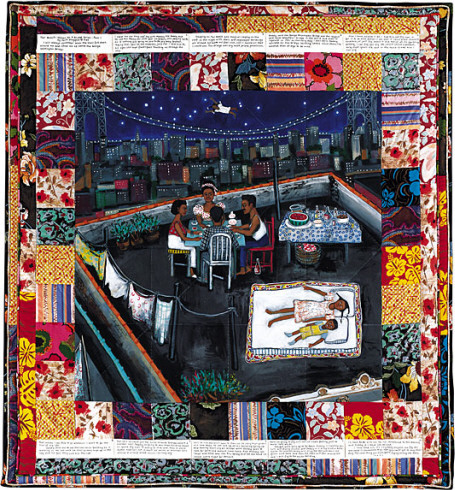
Tar Beach by Faith Ringgold. from http://www.guggenheim.org/new-york/collections/collection-online/show-full/piece/?object=88.3620&search=&page=&f=Title
Creator: Ringgold, Faith
Title: Tar Beach
Type: Story Quilt
Material: digital image of: Acrylic on canvas, bordered with printed, painted, quilted, and pieced cloth
Measurements: 74 5/8 x 68 1/2 inches (189.5 x 174 cm)
Subject: art, story quilt, art — Harlem, African-American artist
Relation: Part 1 Of “Woman on the Bridge” series
Format: digital image/JPG; 455 x 490; 188,904 bytes
Location: George Washington Bridge, New York; Harlem, New York
Date Original: © 1988
Resource identifier: Digital Object #2 NYArchive; 88.3620 at the Guggenheim Museum
Keywords/Metadata: Faith Ringgold; Tar Beach; Harlem (New York, N.Y.); Harlem (New York, N.Y.)—Fiction.; Harlem (New York, N.Y.)—In art.; American Artists; African American Artist; female artist; Women Artists; Family picnics; Picnics; Rooftops; Bridges; George Washington Bridge; Flight—Fiction.; Flight in art.; Story Quilt; painting; paintings (visual works); textile and fiber art; fiber art; Textile fabrics in art.; Storytelling.; African American arts–New York (State)–New York–20th century–Juvenile literature.
–
The painted story quilt is a representation of how Ringgold and her family would go to the roof of their apartment building during hot summer nights, in Harlem, New York. The title Tar Beach comes from the fact that the roof was covered in tar paper. The George Washington Bridge is lit up in the background. Tar Beach is the first quilt in the Women on a Bridge series, and was later adapted into a children’s book with the same name in 1991. The book won a Caldecott Medal and other awards.
The quilt has two girls lying next to the family table, looking at the stars, and a 3rd girl flying over the bridge; this represents dreams for the future and symbolizes freedom, as well as, self-determination. The flying girl in the painting is Cassie Louise Lightfoot, a character created by Ringgold for this series. The text is narrated by Cassie, who says that “Sleeping on Tar Beach was magical …only eight years old and in the third grade and I can fly. That means I am free to go wherever I want to for the rest of my life”. Ringgold also says that the women in this series “are actually flying; they are just free, totally. They take their liberation by confronting this huge masculine icon – the bridge.” [1]
Ringgold was born in 1930s Harlem, New York, which was a time of prejudice and discrimination. She became an activist for feminism, civil rights, and anti-racism. She continues to be interested in how her art can be used to express history and her storytelling. She wants to make sure that African American artists receive the attention and respect they deserved. While at that time, women were not allowed into liberal arts programs such as art, she was able to take art classes while studying to become a teacher. During one art class, the teacher told Ringgold that he thought she did not have the talent to become an artist. This inspired her to pursue her dream of being an artist even more, saying “What matters is determination, not necessarily skill. I wasn’t about to stop trying”. In her biography, she said that “after I decided to be an artist, the first thing that I had to believe was that, I, an African-American woman, could be on the art scene without sacrificing an iota of my African-Americanness, of my femaleness, or my humanity.” [2]
The style of the story quilt was inspired by traditional African American craft, associated with women’s communal work that also has roots in African culture, combined with the storytelling. She took what was seen as traditional female crafts and transformed them into fine art that was acknowledged by all.
NYArchive selected this image because it represents the desire to express oneself freely and to have the liberty to go after your dreams, without being held back by the views of other people and society. Ringgold was a pioneer who got her work shown in 1960, and banded together with other African-American artists to demonstrate in front of the galleries that refused to include African-American art in their collects. They wanted to show through their artwork what it was like to be African-American in America [2]. Another example of this theme is Ringgold’s American People series, which she created in the 1960s.
References
[1] Collection online | Faith Ringgold. Tar Beach (Part I from the Woman on a Bridge series). 1988. Retrieved from http://www.guggenheim.org/new-york/collections/collection-online/show-full/piece/?object=88.3620&search=&page=&f=Title
[2] Art Heritage Program. (2003). Faith Ringgold: October 8, 1930 – present. Retrieved from http://www.artheritageprogram.org/Ringgoldbio.pdf
Related Links
Art Districts Magazine. First comprehensive survey of Faith Ringgold’s politically charged paintings of the 1960s during Art Basel Miami Beach. Retrieved from http://artdistricts.com/miami-art-museum-presents-first-comprehensive-survey-of-faith-ringgolds-politically-charged-paintings-of-the-1960s-during-art-basel-miami-beach/
Craft in America. Faith Ringgold – Writing Tar Beach [Video File]. Retrieved from http://video.pbs.org/video/2229400028/
